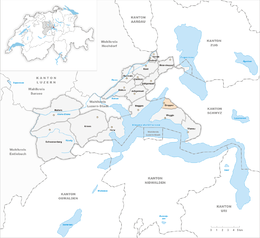Greppen
| Greppen | ||
|---|---|---|
|
||
| Coordinates: 47°03′N 08°26′E / 47.050°N 8.433°ECoordinates: 47°03′N 08°26′E / 47.050°N 8.433°E | ||
| Country | Switzerland | |
| Canton | Lucerne | |
| District | Lucerne | |
| Area | ||
| • Total | 3.32 km2 (1.28 sq mi) | |
| Elevation | 447 m (1,467 ft) | |
| Population (Dec 2015) | ||
| • Total | 1,036 | |
| • Density | 310/km2 (810/sq mi) | |
| Postal code | 6404 | |
| SFOS number | 1056 | |
| Surrounded by | Küssnacht (SZ), Meggen, Weggis | |
| Website |
www Profile (German), SFSO statistics |
|
Greppen is a municipality in the district of Lucerne in the canton of Lucerne in Switzerland.
It lies at the base of huge Mount Rigi. The exclave is separated by Lake Lucerne from the rest of the district.
Greppen shares the history of its neighboring community of Weggis. Mentioned for the first time, albeit indirectly, in 1259 as Crepon, in a document of Heinrich von Heidegg, it belonged to the Habsburgs, and was sold to Lucerne in 1406 as part of the Vogti Neuhabsburg. In 1803 it was assigned to the District of Lucerne.
Greppen lies on the eastern shore of the Küssnacht arm of Lake Lucerne, at the base of Mount Rigi. Greppen stretches from Lake Lucerne up the west slope of Mount Rigi to just below Rigi-Staffel (elev. 1,400 m (4,600 ft)). The Breitenacherreid is a nature preserve.
Greppen has an area of 3.3 km2 (1.3 sq mi). Of this area, 50.9% is used for agricultural purposes, while 39.7% is forested. The rest of the land, (9.4%) is settled. In the 1997 land survey[update], 39.7% of the total land area was forested. Of the agricultural land, 43.94% is used for farming or pastures, while 6.97% is used for orchards or vine crops. Of the settled areas, 7.88% is covered with buildings, 0.3% is industrial, and 1.21% is transportation infrastructure.
Greppen borders on Weggis and Küssnacht in Canton Schwyz. It also shares a water border with Meggen.
In 1798 there were only 240 inhabitants. The population grew until 1860 (1798-1860: +23.8%) and then fell to only by 244 by 1900. In the next twenty years, tourism brought with it rapid population growth (1900-1920: +51.8%). The number of inhabitants then remained about the same until 1980. Since then, the population has grown (1980-2004: +143.8%) because of improved transportation, the municipality's mild climate, and its proximity to Lucerne and Küssnacht. Over the last 10 years the population has grown at a rate of 28.2%.
...
Wikipedia




